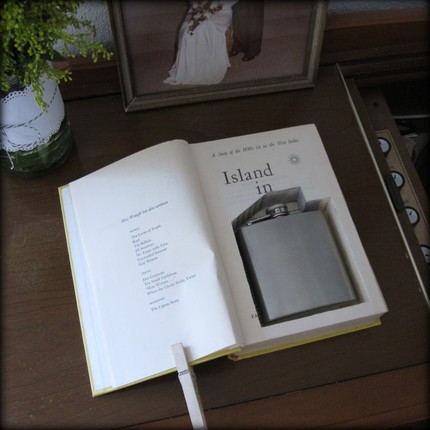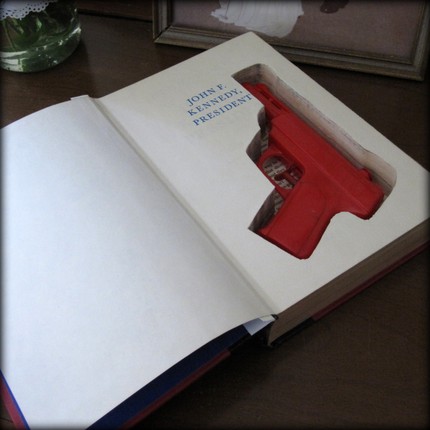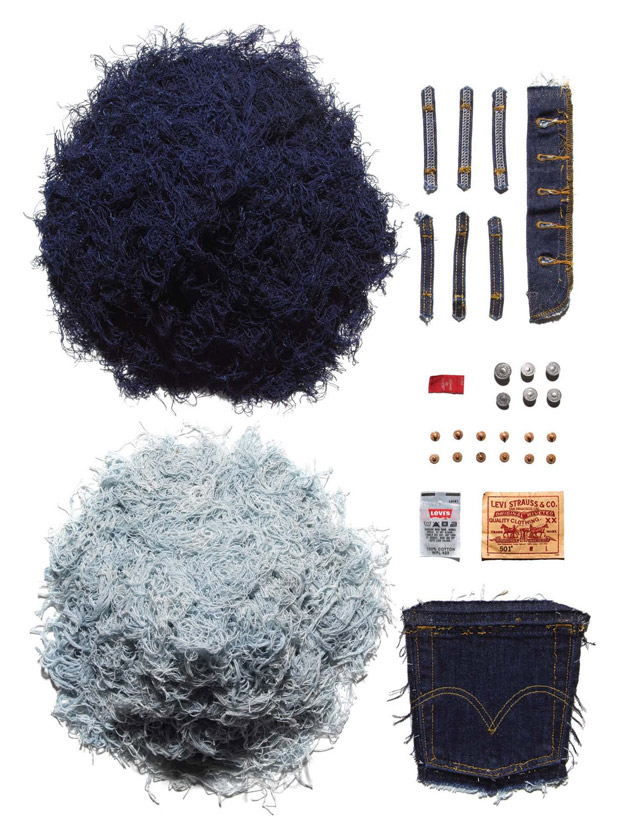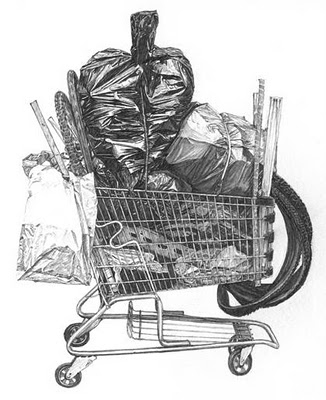
Click to read about Book Bike
Gabriel Levinson, a friend of this site, a contributor to Significant Objects, and the guy doing The Book Bike (mentioned earlier), got a nice writeup in Time Out Chicago the other day. He’s giving out indie-press books and zines this year. The Time Out piece ran with the picture above.
 If you squint very closely — see those zines facing outward in the rack front and center? Those are past issues of Where Were You?, donated by me! I’m famous!
If you squint very closely — see those zines facing outward in the rack front and center? Those are past issues of Where Were You?, donated by me! I’m famous!
Anyway, support Mr. Levinson’s project by donating a few bucks here.
And read/download the latest issue of Where Were You?, which is now an e-zine, here or here.
Posted Under:
rw
This post was written by Rob Walker on May 31, 2010
Comments Off on Where Were You? on The Book Bike!
 BARE NECESSITY:
BARE NECESSITY:
Rejecting baroque shoe technology — for minimalist technology.
When such rationalist techno-complexity piles up, it inevitably attracts a naturalist and human-centric reaction. In this case: What if the athletic shoe is a dumbed-up version of the human foot? How about, in other words, running with no shoes at all?
Read the column in the May 30, 2010, New York Times Magazine, or here.
Discuss, make fun of, or praise this column to the skies at the Consumed Facebook page.
Posted Under:
Consumed
This post was written by Rob Walker on May 29, 2010
Comments Off on In The New York Times Magazine: “Five Finger” Shoes

Click for more.
Moleskinerie pointed out the above item the other day. The maker is an Etsy seller, Pommes Frites. While this object is no longer available, there are other hollowed out books for sale in the Pommes Frites shop.
“This old book has been upcycled into a secret place to hide your moleskine journal!” was apparently the pitch on this one. This again goes to a recurring theme in this series: the book as raw material. You may recall the series actually began as a spinoff of a post on Significant Objects, in which I wondered allowed why that project can’t seem to get any eco-cred for upcycling with words. Maybe if we got writers to invent stories about destroyed books?
Anyway, there’s something particularly fantastic about a hollowed out book that hides, of all things, a journal. (A very special journal, to its buyers at least: See this 2005 Consumed on Moleksines).
Here are some more cool works by Pommes Frites:

Hollow Book -- Flask. By Pommes Frites. Click for more.

Hollow Book Pistol Safe -- SOLD. Click for more, though, it's cool.
Posted Under:
Products
This post was written by Rob Walker on May 28, 2010
Comments Off on Books, the idea, cont’d: Book for hiding a notebook, etc.
On Hypebeast, this from a post titled Sagmeister x Levi’s 501 Art Installation for American Rag. This post part of an occasional series.

Click for more.
Posted Under:
Uncategorized
This post was written by Rob Walker on May 24, 2010
Comments Off on Pictures of Stuff, Cont’d: Jean components

Via Make Mag, click for more.
Brian comes through with a great tip, something I at least knew nothing about. Evidently this is an Oakland thing: Kids who customize their bikes (as in bicycles) in an aesthetic inspired by “scraper” (basically a kind of low-rider with the sort of styling I’m used to seeing on donks) cars. Thus things like Oreo wrappers get incorporated, if the look is right. This isn’t really mutant-bike stuff (yes, yes, I know there’s been a lot of DIY bike customizing for years), it’s more about the look. Anyway some of these creators showed up at the Maker Faire and there’s a Make Q&A here. There’s more info in this YouTube video, also courtesy of Brian. (So Brian: Thanks!)
Posted Under:
Non-Daily Linkpile
This post was written by Rob Walker on May 21, 2010
Comments Off on Linkpile
Via JunkCulture:

Taizo Yamamoto. Click for more.
Part of a series.
Posted Under:
Artists
This post was written by Rob Walker on May 19, 2010
Comments Off on Pictures of Stuff, cont’d: Shoppingcart-full

If you recall the May 3 Consumed on the artwork that sells itself on eBay, which was titled, “A Tool To Deceive and Slaughter,” you may enjoy this:
‘Another Tool To Deceive and Slaughter’ G.E. (2007)
Hi so to begin with please do not confuse this work with Caleb Larsen’s interesting installation A Tool to Deceive and Slaughter.
However, this sale is for a somewhat similar item, in that it is shaped like a box, although the color is white not black, and it will, once installed, perform the exact same function every time its turned on – namely it will shake violently and flood your house. It is a menace in every sense of the word – we are afraid to leave the children alone with it, in fact its eying me aggressively right now, if you ask a question and don’t hear back, assume the worst and send help. It is designed to look exactly, I mean exactly, like a General Electric washer model WHDRR4418G1WW, serial number zm185532G, in fact it so closely resembles a GE washer, that when GE sent a couple of technicians to look it over they assured us it was in fact a GE washer and that it was working perfectly, and that the flooding and shaking were due to our unspecified user error, although they did acknowledge that this model was prone to the symptoms we described. In fact this simulacrum was so effective they even offered to sell us an additional warranty extension on it, which I considered purchasing, but once again this is not a washer, it is device to slaughter and deceive, because if it was a GE washer model WHDRR4418G1WW, serial number zm185532G, then it would actually wash clothes, linens and such, and not flood my house every time we used it.
Terms of sale: you must promise to install this in your home, work, museum, or art gallery and install it exactly as described in an appropriate GE manual. You then must promise to use it on a regular basis. We are not responsible for any damages caused by the flooding and or violent shaking, that is what this item is suppose to do. You may not return it. You may not complain to GE or to anyone else, like Lowes Hardware, but you may resell it so long as the new buyer agrees to the terms of this sale as described above.
Full ebay listing here. Buy It Now for $50k; or “make offer.”
So, there’s an interesting mixture of referencing (and maybe poking fun at?) a Web-discussed artwork in order to, basically, slam a corporation’s apparently flawed product. Neat!
(Thanks, Garth!)
Posted Under:
Non-Daily Linkpile
This post was written by Rob Walker on May 18, 2010
Comments Off on Linkpile
Further thoughts on the gift glut from Rob Horning:
In The Gift anthropologist Marcel Mauss gave some examples of gift-giving potlatches that culminate in the sheer destruction of value in obligatory ritualized sacrifices: “Sometimes there is no question of receiving return; one destroys simply in order to give the appearance that one has no desire to receive anything back.”
I wonder if something like that happens in social media, where the possibility of reciprocation is destroyed by a surfeit of competitive sharing. Because of the ubiquitous ranking possibilities, gift-giving online can escalate into the destructive orgy of the competitive potlatch, in which participants try to outgive everyone else into submission in order to secure a particular identity. On social media, the potlatch takes the form of outtweeting and outsharing the field, overloading the network with fragments of oneself as seek a ranking. The result is that gifts proffered through social media stop seeming like gifts at all. They become referendums on our identity as we are configuring it in that particular instant. The gifts no longer seem reciprocal; they seem narcissistic. Even though we don’t do it for money, we are still back to producing content, not giving.
But the network is now also supposed to be the space in which non-competitive gifts are to be exchanged. The potlatch preening—the produced content—threatens to crowd out those kinds of gifts. So the gifts don’t get recognized and appreciated in the spirit in which they are given, which may lead to a desperate offering of more of them—at which point they become content. This creaties self-reinforcing destructive spiral. In other words, if everyone is oversharing, everyone has to overshare to try to be heard, but in such an environment no one has the time to listen. Paradoxically, sharing destroys gifts.
Horning, by the way, has previously made great points — see here and here — about how online sharing can be considered a form of immaterial labor that benefits the various entities that aggregate our online gifts/creativity/content/data, and monetize it in various ways.
 VALUING $0
VALUING $0
Measuring creative gifts, from worthless to priceless
Think not just of written words but of images, artworks, videos, songs, craft how-to pages and on and on. Surely it’s the case that never before have so many creators offered so much to so many for $0. A result, in effect, is a gift glut.
Read the column in the May 16, 2010, New York Times Magazine, or here.
Discuss, make fun of, or praise this column to the skies at the Consumed Facebook page.
Posted Under:
Consumed
This post was written by Rob Walker on May 15, 2010
Comments Off on In the New York Times Magazine: What’s a gift worth?
- Inventor Saul Griffith learns the limits of technology: Shame the full text isn’t online: Great article on “the inadequacy of addressing complex societal issues with technological ingenuity alone. Nowhere is this problem more apparent than with Griffith’s main preoccupation these days: energy use and global warming.”
- Reverse engineering the perfect (or worst) TED talk – Boing Boing: Somewhat amusing talk is based on “analyzing data” from past Ted talks to isolate the phrases, words, themes, even slide-color-schemes that are and are not effective with the TED audience. My favorite observation is that “it’s okay to fake intellectual capacity,” which can be achieved, for instance, by saying “etc., etc.” instead of “I don’t understand.” Haw.
- Bad writing: What is it good for?: “The secret weapon of many writing workshop: Students often don’t get much helpful advice from critiques of their own work, as more than one teacher has confided to me. Instead, they learn the most from identifying the mistakes made by others.”
- The hunt for universal music: “Psychologists are putting universality back on the agenda, and are investigating whether certain elements of music are hard-wired into the brain.”
- For musicians, economy is the mother of invention: “Enterprising music makers are turning to the Internet and micro-financing through donations.”
These links compiled via delicious, and repurposed here with plug-in Postalicious. Not enough stuff? Not the stuff you wanted? Try visiting unconsumption.tumblr.com, murketing.tumblr.com, and/or the Consumed Facebook page.
Posted Under:
Non-Daily Linkpile
This post was written by Rob Walker on May 14, 2010
Comments Off on Linkpile
Waaaaay back in March, Elliot Van Buskirk of Wired.com posted about “Text 2.0.” A video from a Swedish technology company demonstrates what this means: Basically, eye-tracking technology monitors how you read, and the text itself reacts. Somehow it senses if you want to know how a word is defined, or pronounced, or translated, and it tells you. If it concludes that you’re just skimming, it “fades out irrelevant information” in order to “streamline your reading.”
I have zero interest in this as a reading person. I envision triangulation against databases that cross-matches my eye movements (and thus, by implication, my mind) against some “norm,” thereby sacrificing idiosyncracy and individuality to the fabled CloudCrowd yet again. I also have zero interest as a writing person. I happen to think textual communication with an engaged reader is a truly singular thing, and the idea of some tech firm’s supposed expertise monkeying around in the middle of that connection is depressing. Moreover, in both scenarios, I’m fundamentally skeptical that the real-life quality of the technology will be remotely proximate to the sales pitch. Stuff like this makes me think of a future in which some sort of Clippy equivalent informs me that I don’t actually like Milan Kundera after all.
That said, as someone compiling an occasional series on the idea of the book, I’m very interested in this concept. If something like this somehow compiled individual reader data, straight from the eyeball, it could be another layer on the stuff that Amazon is tracking and broadcasting with its “Kindle highlighting” information. People who believe they need a mass of personal-behavior data to tell them who they are might want to know which passages this tracking software has concluded they like (as opposed to which passages they thought they liked, by highlighting, or simply by, you know, thinking.) Those who like the results might then have an interest in “sharing” them — Text 2.0 could automatically tweet its conclusions (“Turns I out I don’t like Kundera”), per your settings.
As Van Buskirk notes, the appearance of something like Text 2.0 is highly plausible, as the iPad and other e-readers evolve to include cameras; his reporting indicates that many of the relevant patents and business deals already seem to be in motion. (Here’s another link to his writeup.) He also makes the case that eventually this sort of technology could “reinvigorate the written word,” basically giving ebooks a fresh way to compete in the attention economy. Maybe he’s right, and in any case he’s saying what you would probably expect a Wired.com writer to say. But he also says something you probably wouldn‘t expect: At the moment, he’s not really into ebooks:
I should admit that I have yet to make the leap to an e-reader. Having grown up a bookworm in the ’70s and ’80s, I prefer the feel and even the smell of paper books — and the fact that I can just chuck one in my bag for whenever I have a spare moment, without worrying about batteries, theft or breakage.
Probably there are rationally convincing response to these points that any e-reader enthusiast could make — surely paper-book-smell technology is in the offing!
But that’s just the thing — the idea of the book isn’t strictly a rational thing. If it were, there wouldn’t be much interesting about it, now would there?
I’m pleased to say we’ve added another member to the Unconsumption Tumblr team: Molly Block, who describes herself as design-savvy marketing and business development geek, based in Houston. Speaking of Houston, those of you who know the Space City, and who are Foursquare users, ought to be mightily impressed to learn that she is also the “mayor” of the Rothko Chapel (among other spots). How cool is that?
I’d still be happy to have help on improving and beefing up the Unconsumption Wiki. Please get in touch if you’re interested.
Conrad Bakker — mentioned earlier in this series, in this post — tells me (well, me and everyone on his mailing list) about his interesting contribution to Hand+Made: The Performative Impulse in Art and Craft. At the Contemporary Art Museum Houston: May 15 – July 25, 2010
Hand+Made: The Performative Impulse in Art and Craft is a dynamic group exhibition that explores the innovative means by which artists continue to expand the traditional boundaries of art and craft.
Others in the show include friend of Murketing Sabrina Gschwandtner, and Unconsumption-featured soundsuit creator Nick Cave, among others.
Bakker says:
My contribution to this exhibition is Untitled Project: Book-of-the-Month-Club — a simulated book subscription service involving hand- carved and painted sculptures based on paperback books from the 1960s and 1970s, whose subjects range from social issues and existential philosophy to DIY crafts and self improvement. This project examines the way books and their networks of distribution produce a specific gathering of persons, things, and ideas.
Untitled Project: Book-of-the-Month-Club brochures/membership forms are available at the Contemporary Arts Museum Houston, Lora Reynolds Gallery (Austin, TX) and by email request: bookofthemonthclub@untitledprojects.com (if you would like to receive an actual brochure, please include your mail address)
A PDF of the brochure complete with membership agreement and important details in very small print can be found here.
Posted Under:
Artists
This post was written by Rob Walker on May 12, 2010
Comments Off on Books, the idea: “Simulated book subscription service”
 If you squint very closely — see those zines facing outward in the rack front and center? Those are past issues of Where Were You?, donated by me! I’m famous!
If you squint very closely — see those zines facing outward in the rack front and center? Those are past issues of Where Were You?, donated by me! I’m famous!



 "
"

 BARE NECESSITY:
BARE NECESSITY:


















 Kim Fellner's book
Kim Fellner's book  A
A